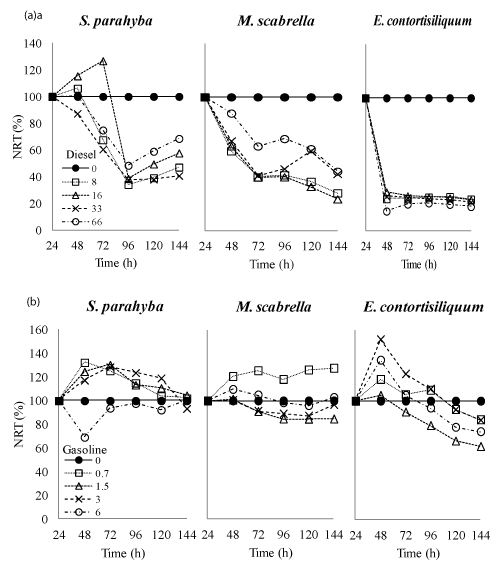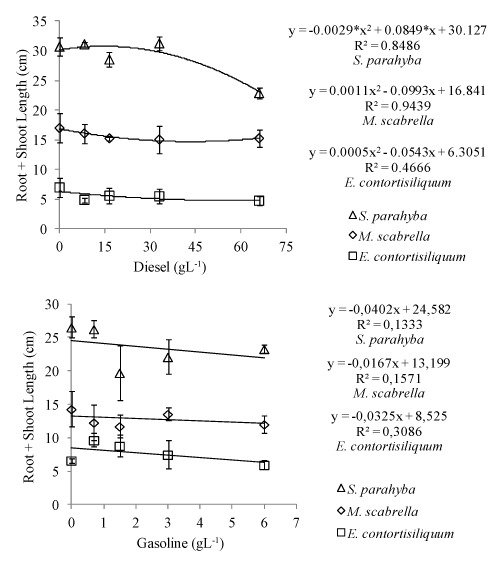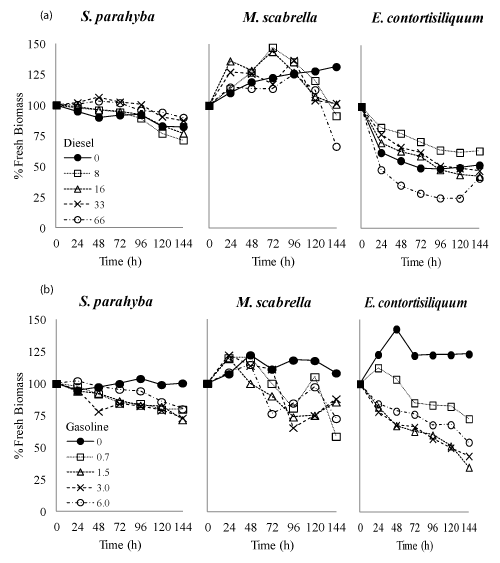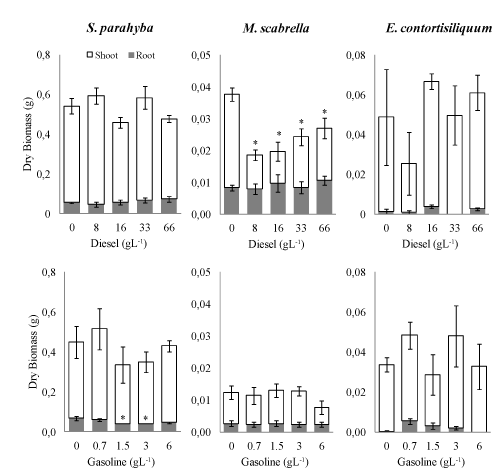Special Issue Article Open Access
Tolerance of Tree Reforestation Species (Schizolobium parahyba, Mimosa scabrella and Enterolobium contortisiliquum) to Gasoline and Diesel Phytotoxicity Assays
| Priscila Jane Romano de Oliveira Gonçalves1, Lucas Coelho Vieira2, Alexandre Verzani Nogueira2, Henry Xavier Corseuil2 and Melissa Paola Mezzari2* | |
| 1Department of Microbiology, Center of Biological Sciences, Laboratory of Microbial Ecology, Universidade Estadual de Londrina, Londrina, Parana 86051-990, Brazil | |
| 2Universidade Federal de Santa Catarina, Campus Universitário Trindade, C.P. 476, Florianópolis, Santa Catarina, 88040-900, Brazil | |
| Corresponding Author : | Melissa Paola Mezzari Universidade Federal de Santa Catarina, Campus Universitário Trindade C.P. 476, Florianópolis, Santa Catarina, 88040-900, Brazil E-mail: mmezzari@gmail.com |
| Received: March 26, 2012; Accepted: June 13, 2012; Published: June 15, 2012 | |
| Citation:de Oliveira Gonçalves PJR, Vieira LC, Nogueira AV, Corseuil HX, Mezzari MP (2012) Tolerance of Tree Reforestation Species (Schizolobium parahyba, Mimosa scabrella and Enterolobium contortisiliquum) to Gasoline and Diesel Phytotoxicity Assays. J Bioremed Biodeg S7:004. doi:10.4172/2155-6199.S7-004 | |
| Copyright: © 2012 de Oliveira Gonçalves PJR, et al. This is an open-access article distributed under the terms of the Creative Commons Attribution License, which permits unrestricted use, distribution, and reproduction in any medium, provided the original author and source are credited. | |
Related article at Pubmed Pubmed  Scholar Google Scholar Google |
|
Visit for more related articles at Journal of Bioremediation & Biodegradation
Abstract
Schizolobium parahyba (tower tree), Mimosa scabrella (bracatinga) and Enterolobium contortisiliquum (earpod tree) are Brazilian native trees used for reforestation of degraded areas. In order to evaluate their probable success on phytoremediation of degraded areas contaminated with petroleum derived compounds, a simple short-term acute toxicity assay with diesel and gasoline was performed. Plants were germinated in contaminant-free conditions and adapted in hydroponic solution prior to the one-week hydroponic toxicity test, which was supplemented with diesel at 0, 8, 16, 33 and 66 gL-1 and gasoline at 0, 0.7, 1.5, 3 and 6 gL-1. Parameters examined were fresh weight, root and shoot length, dry biomass and transpiration rate. Phytotoxic effects on transpiration analysis from gasoline were less severe than diesel. S. parahyba, M. scabrella and E. contortisiliquum presented a maximum reduction of 59%, 76% and 82% in transpiration from diesel toxicity test. Diesel affected significantly both M. scabrella (dry weight) and S. parahyba (fresh biomass and height), whereas gasoline significantly reduced S. parahyba dry weight. Results suggest that Enterolobium contortisiliquum is the most tolerant species to diesel and Mimosa scabrella to gasoline. The present research shows the feasibility of the short-term hydroponic study as a primary evaluation of diesel and gasoline toxic responses from selected native trees.
| Keywords |
| Phytotoxicity; Hydroponic solution; Gasoline; Diesel; Schizolobium parahyba; Mimosa scabrella; Enterolobium contorstisiliquum |
| Introduction |
| Fossil fuels are still the main source of energy representing approximately 80% of the total world supply [1]. However, its exploration, recovery and use present serious environmental problems, which are mainly associated with the production of greenhouse gases and contamination of land and water resources [2,3]. In Brazil, most soil contamination is related to accidental chemical spills from road transportation. A recent report from São Paulo State have revealed 461 accidental spills during the year 2010 and among these, 40% are related to flammable liquids (diesel oil, ethanol and gasoline) [4]. In industrialized areas, the main source of groundwater and soil contamination comes from old underground storage tank leakages [5,6]. São Paulo State alone has reported 738 accidental spills from gas stations within the last 32 years [4,5]. |
| In the case of a spill, Brazilian commercial gasoline containing 20-26% ethanol facilitates the transfer of BTEX compounds (benzene, toluene, ethylbenzene and xylenes) and polycyclic aromatic hydrocarbons (PAHs) into aqueous phase because of the cosolvency effect [7]. Normally BTEX makes up around 18% (by weight) of the total hydrocarbons present in a standard gasoline and Brazilian diesel. Though representing only a fraction of the total fuel composition, the presence of ethanol in gasoline can increase the solubility of benzene, toluene and total xylenes by 67%, 89% and 90%, respectively [7]. In the case of simultaneous spills and leaks with diesel and ethanol, solubility of these monoaromatics from diesel increases by 29%, 34% and 80%, respectively [7]. |
| Considerable accidental spills in land are derived from pipeline ruptures followed by the release of large volumes of contaminants such as crude oil and petroleum products. Case studies include one major accident that occurred in 2000, where a spill of 4,000 m3 of crude oil from a pipeline rupture affected the Araucaria Pine Forest ecosystem located in the state of Paraná (south Brazil) [8]. The released crude oil contains polycyclic aromatic hydrocarbons (PAHs), which are a group of recalcitrant and hazardous chemicals that may exhibit harmful effects on soil organisms including microorganisms, soil animals and plants [9,10]. The remediation techniques used to avoid the spread of contaminants included containment, soil excavation, soil and vegetation removal, water injection and oil recovery, drainage and irrigation. Bioremediation was applied as the only biological treatment technique chosen at the site [11]. |
| Phytoremediation is an alternative to more expensive remediation technologies because it is a feasible, effective and non-intrusive technology that utilizes natural plant processes to enhance degradation and removal of contaminants from the environment [12-16]. Once contaminants are assimilated from the environment and translocated within plant tissues, they are transformed and/or stored by metabolic processes [17-20]. After the spill in the Araucaria Pine Forest, several investigations were elaborated to analyze the effect of the contaminated soil on the growth of native plant species and their potential for on-site phytoremediation application [21-31]. From these studies, native Brazilian trees that were tolerant to oil-contaminated soils were Mimosa caesalpiniifolia, Mimosa pilulifera, Sebastiana commersoniana and Schinus therebinthifolius. Besides the fact that these species may be used for phytoremediation of oil-contaminated soils, most of them are generally used for the recovery of degraded areas such as abandoned agricultural lands, mine rehabilitation sites and metropolitan areas [32- 34]. Very few studies have used reforestation species for germination and growth in oil-contaminated soils, and these have showed that Enterolobium contortisiliquum is efficient in removing polyaromatic hydrocarbons (PAH’s) from soil, however Mimosa scabrella growth and biomass is significantly reduced in the presence of petroleum hydrocarbons [26,35]. There are no reports in the literature with Schizolobium parahyba and recovery of degraded soils by oil products, but it is believed that this species has potential as a phytoremediator since it is a pioneer tree and one of the fastest-growing native species used for reforestation [36]. |
| Phytotoxicity studies with crude oil on native Brazilian trees included plant growth, root length, produced biomass, tissue analysis, etc. Typical phytotoxicity studies with trees for phytoremediation application also include elaborated research on uptake potential, metabolic pathways, in vitro systems with cell suspension, hairy root cultures, etc [37-39]. Thus far, no standard toxicity method has been developed for analysis on trees. One recent approach using a standard method is the adaptation of Microtox® (ASTM method D5660-1995) for phytotoxicity of poplar cuttings [40]. In addition, technological advances in genomic research have provided new tools for phytotoxicity studies, such as the Affymetrix® microarray with the poplar tree genome (model tree for phytoremediation studies) on a GeneChip® [41-43]. Nonetheless, techniques involving genetic analysis for toxicological tests are costly, and a simple and cheaper alternative with an acute phytotoxicity assay has been proposed [44]. The proposed test was developed in hydroponic systems and the parameters used for toxicity responses were transpiration, growth and water use efficiency. Hydroponic systems allow rapid selection of individuals, reducing the space required to experience variability due to environmental factors, growth and treatment time of the plants [45]. |
| In the present work, three native species that are generally used for restoration of degraded areas were selected for the short-term acute phytotoxicity assay [44] with diesel and gasoline in order to evaluate their potential for future phytoremediation applications. The objective of this study was to investigate the growth of Schizolobium parahyba, Mimosa scabrella and Enterolobium contortisiliquum in the presence of different concentrations of gasoline and diesel using simple hydroponic systems for fast analysis and easier interpretation of results. |
| Materials and Methods |
| The experiment was conducted in a greenhouse at the Federal University of Santa Catarina (Florianópolis, Brazil). With the exception of S. parahyba, whose seeds were collected from four trees on campus, the other two species were purchased from local garden stores. Seed dormancy was overcome by the process of thermal and mechanical scarification. Thermal scarification was performed on S. parahyba and M. scabrella by immersion of seeds in boiling water followed by cooling for 24 hours [46,47]. Seeds that showed no peeling were submitted to the process again. E. contortisiliquum seeds were submitted to mechanical scarification using a seed scarifier (Forsberg) performed at 1725 rpm with 60-grit sandpaper causing soft abrasion at the basal end of the seed for 20 seconds [48]. |
| After scarification, seeds were placed in transparent plastic boxes containing paper towels moistened with deionized water. Seeds germinated in the greenhouse supplied with natural sunlight and at room temperature (averages between 30 and 16°C). Plants with welldeveloped roots were transferred into foil-wrapped flasks containing half-strength Hoagland nutrient solution at pH 6.8 [49]. S. parahyba plants with approximately 5 cm of root length were transferred into 250 mL Erlenmeyer flasks, whereas M. scabrella and E. contortisiliquum (8 and 2 cm of root length, respectively) were transferred into 30 mL test tubes containing enough nutrient solution to cover their roots. Plants were adapted to nutrient solution for a week in the greenhouse under natural light and at room temperature (23 ± 5°C). The nutrient solution was replaced every two days. |
| Diesel and gasoline were purchased at a local gas station and used for toxicity tests in hydroponic solution. Five different concentrations of diesel (0, 8, 16, 33 and 66 gL-1) and gasoline (0, 0.7, 1.5, 3 and 6 gL-1) were analytically calculated to allow the most toxic compounds from fuels (BTEX) to enter the water-soluble fraction at increased concentrations. Tests were arranged in triplicates of the same plant species and these replicates were grouped based on the average plant biomass (fresh weight). All triplicates were exposed to each of the five concentrations used. |
| Daily analysis was performed to measure the increase in plant biomass (fresh weight), plant height (stem base to the tip of the leaves), root length and transpiration. For transpiration analysis, the weight of the reactor with solution was measured every twenty-four hours and the recorded weight loss was due to transpiration of plants. The nutrient solution with diesel or gasoline treatment was totally replenished every day until the end of one-week analysis. The results of absolute transpiration of the studied species were converted into normalized relative transpiration (NRT) through the equation proposed by [50]: |
 |
| where C is the concentration of the compound in hydroponic solution (mgL-1), t is the time period (h), T is the absolute transpiration (gh-1), i is replicate 1, 2,... n and j is control 1, 2,... Schizolobium parahyba; Mimosa scabrella; Enterolobium contorstisiliquum [39]. |
| At the end of the experiment (after six days), plant tissues (roots and stems) were dried in a convection oven at controlled temperature (70°C) for 72 h to measure biomass dry weight. The effects of diesel oil and gasoline doses on plant growth (cumulative transpiration, fresh and dry weight, root length and shoot height) were determined by analysis of variance (ANOVA) and then to Tukey’s LSD test; F-values were obtained when significant. These tests were performed at the 0.05 significance level using OriginPro 8 software tool OriginLab 2008 on a Windows-based system. |
| Results and Discussion |
| Diesel phytotoxicity |
| The effect of diesel oil on plant transpiration during the “free phase” experiment is represented by the normalized relative transpiration in Figure 1a. S. parahyba showed decreased transpiration in the presence of diesel in all doses tested. Transpiration was reduced by 53%, 42%, 59% and 26% at 8, 16, 33 and 66 gL-1, respectively. The effects were more severe for M. scabrella and E. contortisiliquum, with a maximum reduction of 76% and 82%, at 16 and 66 gL-1, respectively. It was observed that the toxic reaction represented by low transpiration rates started at 48 h for M. scabrella and E. contortisiliquum, and later for S. parahyba. Transpiration rates were variable for S. parahyba, as observed by the small percentage increase after 72 h of exposure to diesel. M. scabrella showed a continuous decrease in transpiration throughout the whole experiment. The effects on E. contortisiliquum transpiration were somewhat more pronounced, with an average decrease of 77% after 48 h for all doses tested. Results from other studies have also reported severe effects and death of plants (Salix alba) exposed to diesel within a few weeks of experiment [50]. It was also noted variable transpiration rates and some recovery of S. alba before drying out and dying. Soil experiments with diesel at 1000 mg kg-1 also indicated decreased transpiration for S. viminalis and Populus nigra, though with much less sensitivity (15 to 25% decrease after 120 h of exposure) [50]. |
| Plant transpiration was limited by diesel uptake, which was clearly observed by the bioaccumulation of diesel compounds and darkening of the stems and leaves in all three species (data not shown). When oils are assimilated by the plant, it travels in the intercellular spaces and also in the vascular system, causing a reduction of the transpiration rate by blocking stomata and intercellular spaces [51]. Therefore, transpiration reduction was attributable partially from physical effects followed by chemical toxicity. The observed differences between species may be related to weight, size and surface area of leaf, canopy, stage of growth and climatic factors [35]. The reaction time of the contaminant in hydroponic phytotoxicity tests is longer for trees with higher biomass [37], as observed for S. parahyba in the present study. In addition, studies with model simulations predicted that contaminant translocation to leaves takes longer for lipophilic chemicals (e.g., diesel) and for large plants [52,53]. |
| Increasing diesel concentrations affected shoot height of S. parahyba, which was significantly reduced by 25% when compared to non-exposed plants. A non-linear regression curve model showed the reduction in height for S. parahyba (R2 = 0.84) at all diesel concentrations tested (Figure 2). No statistically significant differences (p ≥ 0.05) were noted in either root or shoot growth of M. scabrella and E. contortisiliquum. Some investigations have reported decreased growth in height of Brazilian native plants exposed to petroleum contaminated soils obtained from the accidental spill in Parana state. These studies reported 25% height reduction of Schinus terebinthifolius and slow development and altered root structure of M. pilulifera seedlings [22,27-28]. |
| Diesel negative effects in fresh biomass were only significant for S. parahyba, where it was observed a reduction of 18% after 144 h of exposure to diesel at 33 gL-1 (Table 1). Figure 3 (a) represents fresh biomass percentage production for all three species exposed to diesel. It was clearly observed that biomass loss occurred throughout time for all doses tested, but these were not significant to M. scabrella and E. contortisiliquum (Figure 3). M. scabrella and E. contortisiliquum had a maximum decreased production in fresh biomass of 66% and 25% when exposed to diesel at 66 gL-1, respectively. Additional studies with M. scabrella and M. pilulifera exposed to petroleum contaminated soil from the accidental spill in Araucaria (Paraná), showed that these species were significantly affected by the presence of TPHs at a concentration of 13 gkg-1 in soil [26,28]. It was reported that an 80% decrease in height and 88% decrease in biomass of M. scabrella after 58 weeks of exposure to TPHs [26]. Seedlings of M. pilulifera showed root structure alterations with increased production of root hairs, probably as a response to increase surface contact to soil for more absorption of water and nutrients [28]. Other studies have reported tolerant tree species without statistical differences in plant biomass for Allophylus edulis, Campomanesia xanthocarpa and Podocarpus lambertii growing in soil contaminated with petroleum hydrocarbons [29]. |
| Contamination by petroleum and diesel affects plant development due to the oil film formed covering roots, thus intercepting the absorption of water and nutrients [29,54-57]. In the present study, it was observed that roots from all three species (S. parahyba, M. scabrella and E. contortisiliquum) were darkened by the presence of diesel in hydroponic system (data not shown). When roots are affected, the whole plant metabolism is compromised, as well as biomass production and development [26]. Some plant species are able to grow in petroleum contaminated soils, though with decreased photosynthesis and biomass production [27,58]. |
| No statistically significant differences were noted in either shoot or root dry biomass of S. parahyba and E. contortisiliquum. M. scabrella showed statistically significant difference (P<0.05) for stem dry weight at all concentrations (Figure 4). Decrease in dry biomass of native Brazilian trees exposed to petroleum contaminated soils have been registered for S. terebinthifolius, Sebastiana commersoniana, Podocarbus lambertii, M. scabrella, M. pilulifera, M. caesapiniifolia and Eugenia uniflora [26,29,38]. However, other studies have concluded tolerance of Allophylus edulis, Campomanesia xanthocarpa, Podocarpus lambertii, Tibouchina granulosa and S. commersoniana to petroleum contaminated soils [21,24,29-31]. |
| Gasoline phytotoxicity |
| The normalized relative transpiration of plants exposed to gasoline was increased (above 100%) for S. parahyba, M. scabrella and E. contortisiliquum (Figure 1b). Increased transpiration is a result of the chemical properties of gasoline compounds, which are more bioavailabe, taken up faster into trees and are more mobile inside the trees than diesel [52,59-62]. In closed hydroponic reactor experiments, BTEX compounds were found to be readly taken up by poplar cuttings, translocated to the leaves, and transpired from the leaves to the atmosphere, representing a significant pathway [60]. Similar studies in hydroponic reactors also observed increased transpiration of ethanol and benzene mixture by willow tree [63]. Throughout the entire exposure time, S. parahyba showed decreased transpiration at the highest gasoline dose (6 mgL-1). M. scabrella was more susceptible to doses higher than 1.5 mgL-1 and E. contortisiliquum had decreased transpiration rates for all gasoline doses tested after 96 h of exposure (Figure 1b). No statistical differences were observed for the cumulative transpiration rates during the entire experiment. |
| Gasoline caused modest decreases in transpiration and height in all three species, which can be observed by the linear regression curve model tendency (Figure 2). However, all three species did not show any statistical significant differences in height. Interestingly, the increasing gasoline concentrations negatively affected fresh biomass, which was reduced by 20%, 28% and 46% for S. parahyba, M. scabrella, and E. contortisiliquum, respectively at 6.0 gL-1 (Figure 3b). Though loss of fresh biomass was clearly visible on average values, no statistical differences were obtained because of the elevated coefficient of variation values (Table 2). However, plants were clearly smaller and thinner, with signs of chlorosis and dried leaves (data not shown). Dry biomass from gasoline experiment showed smaller values than in plants from diesel experiment, indicating stronger toxic effects than diesel (Figure 4). Very few experiments have used gasoline to analyze toxicity response from plants. An investigation with poplar cuttings exposed to benzene at varied concentrations between 1 and 100 ppm revealed no toxic effects after 17 days of experiment [39]. On the other hand, the toxicity of fresh and weathered gasoline fuel to willow and poplar trees was reported to be fatal at 1000 mg/kg of contaminated soil after 192 h of experiment [50]. Recent studies have reported that gasoline, at different concentrations in soil (20, 40 and 60 mL kg-1), can affect time of germination, germination percentage, plant height, leaf production, shoot and root dry matter from wheat, alfalfa, clover and barley [64,65]. |
| Conclusions |
| Short-term phytotoxicity with S. parahyba, M. scabrella and E. contortisiliquum exposed to diesel and gasoline in hydroponic solution has been tested. Transpiration of plants was reduced to an average of 35% when exposed to diesel. Gasoline doses either increased transpiration or were related to the water volume transpired by plants, since gasoline compounds are more bioavailabe for uptake and more volatile [60]. Only E. contortisiliquum showed reduced transpiration to gasoline over time, which corroborated to decreased fresh biomass loss at the end of the experiment. Statistical results for gasoline treatment proved that M. scabrella was more tolerant than S. parahyba and E. contortisiliquum. General observations for diesel showed that E. contortisiliquum was more tolerant, followed by M. scabrella and S. parahyba. |
| In the present work, short-term hydroponic studies are suggested as a primary evaluation and fast analysis of acute toxicity test in selected plant species and screening for phytoremediation. Though, hydroponic experiments are performed in the absence of contaminant sorption processes in soil, which can reduce plant contaminant uptake (10- to 100-fold) [60]. Therefore, further studies with biomass production in soil would give additional information to expand to field situations, where growth and survival in the field can be negatively affected, as clearly observed by previous studies [50]. Also, the removal of contaminants and their metabolic transformation in trees should be studied in order to confirm the occurrence of phytoremediation. |
| A scarce number of studies have evidenced phytotoxicity of petroleum derived products on trees used for reforestation of degraded areas. Thus, comparison of results becomes difficult based upon limited studies with specific compounds. It is crucial that more research be conducted on the selection of native tree species for phytoremediation applications coupled with reforestation of petroleum contaminated areas. |
| Acknowledgements |
| Thanks to the lab team from the Federal University of Santa Catarina: Marina Carrieri de Souza, Amanda Hoffmann, Júlia Corrêa de Oliveira, Letícia Aparecida Zampieri Costa, Luiza Becker Pereira, Maria Luíza Coelho da Rocha, Marina Bacha Nascimento and Sarah Samuel Schneider for sample preparation and data collection. Appreciation is also extended to CAPES (Programa Nacional de Pós- Doutorado – PNPD) for financial assistance and a scholarship. |
References
|
Tables and Figures at a glance
| Table 1 | Table 2 |
Figures at a glance
 |
 |
 |
 |
| Figure 1 | Figure 2 | Figure 3 | Figure 4 |
Relevant Topics
- Anaerobic Biodegradation
- Biodegradable Balloons
- Biodegradable Confetti
- Biodegradable Diapers
- Biodegradable Plastics
- Biodegradable Sunscreen
- Biodegradation
- Bioremediation Bacteria
- Bioremediation Oil Spills
- Bioremediation Plants
- Bioremediation Products
- Ex Situ Bioremediation
- Heavy Metal Bioremediation
- In Situ Bioremediation
- Mycoremediation
- Non Biodegradable
- Phytoremediation
- Sewage Water Treatment
- Soil Bioremediation
- Types of Upwelling
- Waste Degredation
- Xenobiotics
Recommended Journals
Article Tools
Article Usage
- Total views: 15934
- [From(publication date):
specialissue-2013 - Dec 05, 2025] - Breakdown by view type
- HTML page views : 11270
- PDF downloads : 4664
